One of the most common questions I get is Sea-doo watercraft VS. Yamaha™ waverunner. It’s a fair question to ask since they’re the big names in the industry.
It can be hard to really see the difference in them since there is so much info out there. In this post, I want to point out what makes Seadoo the better option over Yamaha™ when it comes to jet skis.
Also, this review gives you a better idea of Seadoo watercraft you should buy too.
Hull
Here is a simple breakdown of all the hulls Seadoo makes, feel free to click on it to expand it.
As you can see you have 4 different hulls. Each with its own features and riding comfort. The GTX and RXT hull have the S3 Hull which rides the best. The GTI hull is more playful and fun. The Spark is the most compact and lightest in the industry. The T3 hull is the racing hull.
Don’t forget to check out the must have jet ski accessories too!
Model
The above picture gives you a better idea of all the models at a glance. You can see the features of them all and compare them to each other.
Features
Below is the features and what Seadoo Watercraft, feel free to click on it to zoom in.
Sea-Doo Spark
The first machine in the lineup is the Seadoo Spark. Yamaha™ doesn’t have anything that can compete with it. The closest thing is the Yamaha™ V1, but it’s not really that close.
The Spark comes in much cheaper and gets better gas mileage. The closest thing the V1 compares to is the 3up 90HP Spark base, but the 3up 90HP base Spark cost $6,399 while the V1 is $7,899.
The V1 lacks reverse, neutral, and only goes forward. You can get a fully loaded 3up 90HP Spark for $7,399 and the fully loaded Spark has reverse, starts in neutral, has brakes, two keys (fast key and learning key) and so much more. Also, the kicker is the Spark is better on gas!
It’s not fair to compare the Spark to the V1 since Yamaha™ has nothing like it and won’t have anything like it for years. It will be interesting to see the Spark Version of the Yamaha™ since Seadoo has many patents on it. It will be like the RIDE system they use, where to avoid the patents they change some wording around and make it seem new when really its just a copy of the Seadoo iBR.
Seadoo has had iBR since 2009 and is actually on generation 2.0. Yamaha™ has come up with RIDE which tries to copy the iBR system, but does it differently to avoid the patents. Yamaha™ RIDE came out in 2015 so it’s still very new to the game. iBR is brakes and reverse. With iBR you always start in neutral everytime. iBR makes docking a lot easier too!
If you want to learn more about the Sparks I have a review on the 2016’s here.
Sea-Doo GTI 130 VS Yamaha™ VX
Up next is the GTI 130 vs Yamaha™ VX. One killer feature of the Seadoo GTI and all models from here on is that they have iBR. iBR is the reverse, brakes, starts in neutral, and forward. This iBR gives you better control of the machine and makes docking easy. Seadoo is the only watercraft with brakes on the water.
Seadoo is also the only watercraft manufacturer to use Closed Loop Cooling. This is the same system your car uses to keep the engine cooled. This also keeps corrosive salt or lake water away from the engine. Yamaha™ uses an open loop which takes in salt or lake water to cool the engine. The open loop that Yamaha™ uses also takes in debris like pollen or whatever is in the water which can clog the cooling system if you’re not careful. Here is more info on the cooling systems.
You also get the learning key with all the Seadoo models from here. This learning key allows you to program it from 32mph to 50mph. So you can set the speed for the person driving. The keys are also digitally encrypted too, which means no one can just jump on and drive off with it. Seadoo is the only watercraft company to have a digitally programmed key.
Learning key how-to video…
Interesting…
What is interesting is that Yamaha™ released a new Engine called the TR-1. For the longest time, Yamaha™ has been bashing Seadoo for having a 3-cylinder engine while they had 4. Yamaha™ claimed that bigger displacement was key, but they always lacked horsepower which is the most important.
The new engine is basically trying to be the Spark engine, I don’t blame them for that since it’s a great design. The problem is that this new engine really lacks the power that Seadoo has. Yamaha™ doesn’t display what Horse Power their machines have so it’s hard to compare them. I do know the new engine has less than 130HP which the base GTI has. You can also get a GTI with a 155 engine. Here is a post I did on the top speed of all the Seadoo Models.
The move to the smaller engine was for them to get better gas mileage. This is good, but what about when you need power for pull sports? What Seadoo did was that they give you 3 different modes that change the engine. You have your default touring mode which is a slow take off to top speed. Then you have Sport mode which gives you full power. Then you have ECO which gives you the best gas mileage. This allows you to choose the riding you want to do, you got full power or great gas mileage at a push button away.
Sea-Doo GTI VS VX Deluxe/Cruiser
Wake
Yamaha™ doesn’t have anything that is related to the Wake Series. The Wake models have a ski pylon on the rear for pulling tubes and skiers, it get’s the rope up higher – it’s easier on the skiers. Also, you get a wakeboard rack for holding the wakeboard.
The best part is the Ski Mode where you select the experience of the person you’re pulling and set the speed. The driver just holds the trigger in and you get the same perfect pull every time.
Sea-Doo GTX VS Yamaha™ FX Cruiser
It’s hard to compare the Seadoo models with the suspension to any Yamaha™ models since Yamaha™ doesn’t have anything like it. I’ve done a write-up of the suspension and how it works here.
Sea-Doo GTX Limited VS FX Cruiser
Performance Models
300 HP and aS 260
Sea-Doo has 300HP while Yamaha™ does not. The closest thing in HP Yamaha™ has to what Sea-Doo has is any of the models with 260HP. The 300HP models Sea-Doo have are just crazy in power, I’ve written more about it here.
RXP-X 300
How To Drive A Sea-Doo
I wanted to add this part. I have a video where I show you a good bit of the features on a modern Sea-Doo and how you drive one with iBR. It gives you a good idea of how to drive, don’t worry its a lot easier once you hop onto one and take off.
One Last Thing…
What I noticed is the Comfort on a Seadoo is much nicer. The look is also much cleaner. For example, Seadoo doesn’t have any exposed screw holes that are visible like what Yamaha™ has.
Here is an example of Yamaha™ having exposed screw holes…
The problem with having these exposed screw holes is that it looks bad, but also I worry about getting my fingers caught in them. The biggest reason it just looks ugly. It could be just a preference for me, but if I was spending this much on a jet ski I want it to look good and not look like its slapped together as an afterthought.
Here is what a Seadoo looks like, looks very clean…
Also, all the buttons on the Seadoo are within reach of the thumb.
The Floor Mats
Another thing I’ve noticed is that Yamaha™ uses mats that don’t feel good on the feet after a while. This is something you miss when shopping since you have shoes on. The mats on the Yamaha™ are these sharp lines that cut into the feet over time, I’ve got sensitive feet and it was one of the things I notice when riding.
Here is an example of the Yamaha™ Floor Mats…
Here is an example of the Seadoo mats below with its flush mats…
Some models of Seadoo don’t have these flush mats, but they’re less harsh than what’s on the Yamaha™.
Here is an example of the other mats that Seadoo uses which feel good on the feet…
New for this year is Seadoo’s Palm rest. These things work well and really are comfortable. Seadoo really has paid close attention to rider comfort and it shows. Here is what the palm rest look like…
Notice how the grip on the Seadoo is nice and flush. It feels good in the hands which are important when you have that strong grip when riding.
*This post was created to inform people of the difference of Seadoo and Yamaha™. The goal is not to put down one manufacturer over the other, just point out what makes them different to me.

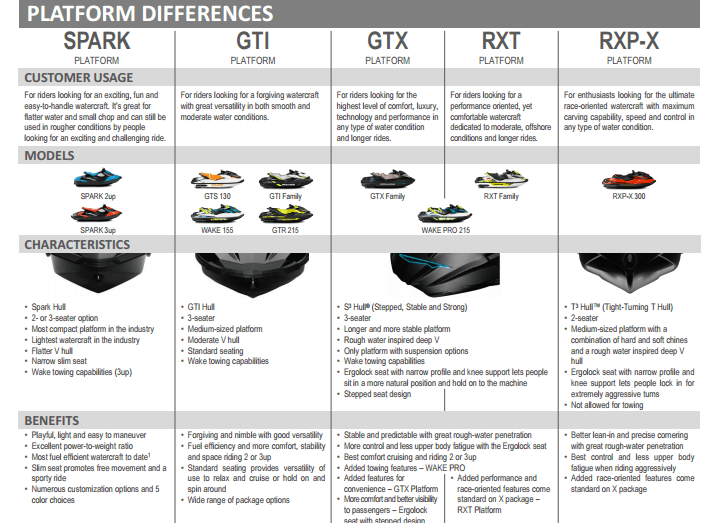








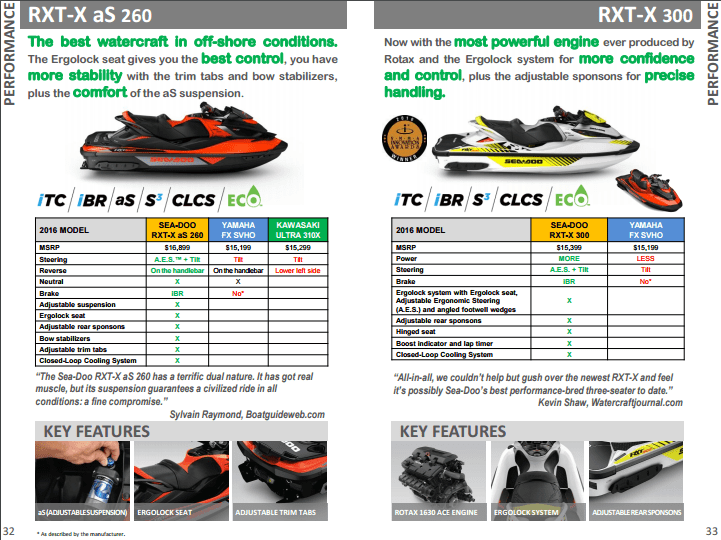

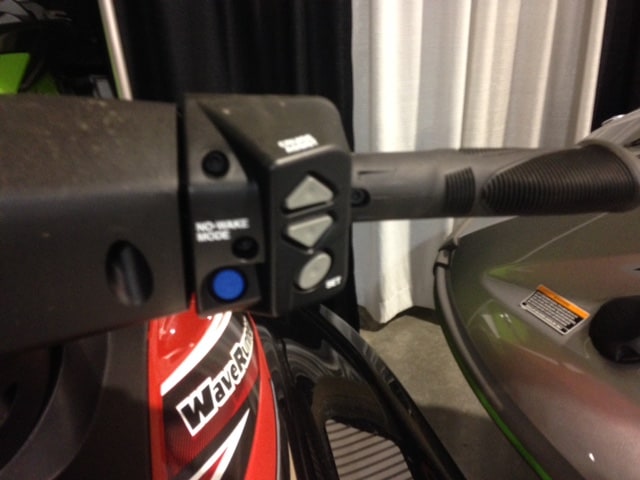



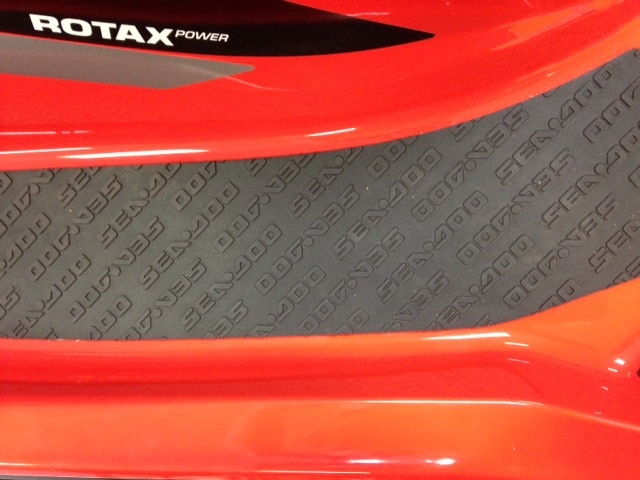
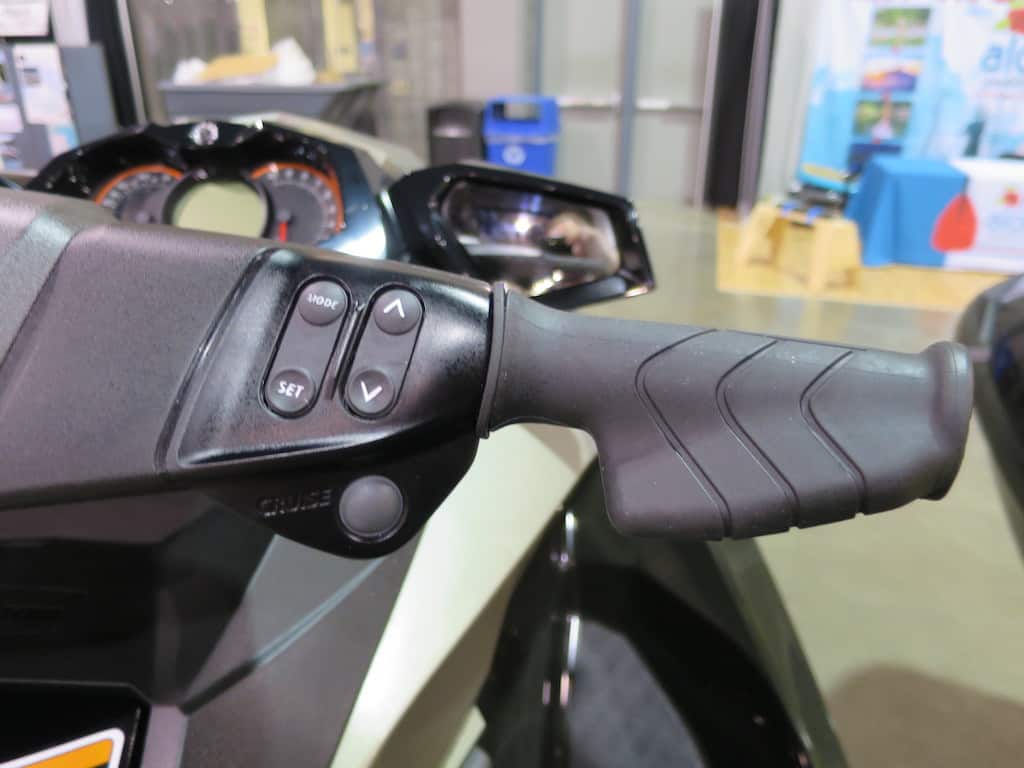
Hi Steven! Soaking up information on your site and loving it! Would love your thoughts and opinion on this. I am looking at purchasing a 2nd ski for the family and have found two that I am interested in and would love to know what you think: First one is a 2016 Waverunner V1 Sport with 20 hours on it (yes, only 20 and they never even put the registration stickers on it!) It comes with trailer and cover, asking $6500. The other option is a 2008 GTX 155 with 195 hours. Comes with trailer, new seat, new battery, new kicker stereo with 4 speakers, asking $5500 OBO The 2016 Yamaha with 20 hours is hard to walk away from but I love the look of the GTX and it looks just as new and could probably get it for $5,000. Thoughts??
I would for sure go with the 2016 Waverunner V1 Sport. What worries me the most about the GTX is the stereo system which would be an aftermarket install and you don’t know what they did. I’ve seen people install speaker systems and it kills the battery because the manufacturer never planned for people to have them.
Hi, I’m under a similar predicament. I would be curious of your recommendation!
1. 2016 Yamaha V1 Sport with 16 Hours, trailer, but not registered for $6500
2. 2004 Yamaha FX 140 with 100 Hours, no trailer, registered for $4900
The 2016 seems like the no brainer, but the person selling the wave runner says that she doesn’t live close to the water, therefore I can’t test it. Thoughts on this? Or ways that I can dry land test the wave runner?
I sure am getting a few more 2016 Yamaha V1 Sports for exactly $6500 lately – it’s starting to scream scam. The 2016 sounds like the better deal but I would be very cautious as it’s not often I get the same year jet ski, model, low hours, and price shows up multiple times. It’s better to water test it because running it on land doesn’t cover all the things. Like cooling, if the pump is working fine, and many more things can only be tested on the water. I wouldn’t go for the 2004 FX either, If you’re in the US better deals are sure to come as we get closer to winter. If you’re in AUS then that might be the best deal you’ll get for a while.
Hello Steven. Thanks for this valuable website/posts, i reference constantly 🙂 I appreciate your hard work and opinion. I recently bought a used ’07 Yamaha FX this summer, took it out twice already to Lake and river. But I live in CA near Long Beach and wanted your opinion on running the waverunner in salt water. Do you suggest I keep it out of salt water? Its an easy 10min trip to ocean rather than a 3 or 4 hour drive to rive/lake. what do you think?? Thanks in advance.
Saltwater is fine but make sure you flush it after you’re done riding in the saltwater. https://www.youtube.com/watch?v=ySFN91bE65c
Thanks for this great informative website!! I will be a first time buyer and searching the used waverunners sites and came across 2016 yamaha V1 Sport. But its from a Rental company near a resort, so probably lots of use out of them. From the descriptions and pictures posted they appear to be in good shape. What are your thoughts on buying from a Rental company? I am assuming the mechanical parts would be somewhat well maintained if they are have them as rentals. As a first time buyer (looking for 2 waveruners) – What are your thoughts?
I avoid buying rental PWCs because they always have high hours and ridden by people who don’t care about them or don’t fully know how to use them. It’s a real gamble as these machines get rode very hard. Not only that but if you decide to sell it later you’re going to have a lot of trouble because of the number of hours they have on them. It’s not too crazy to see a 3-year-old rental unit with 300 hours, that is what I would expect out of a ~10-year-old jet ski.
UPDATE, Rentals use ymahas not only bc they are cheaper, they are simpler and easier to mantain and last longer. This is easy… Toyota vs Mercedez.
I have heard that reliability of Yahama is better than Sea-Doo
I would appreciate some insight
Yamaha makes great machines but I feel Sea-Doo takes the bigger steps forward in new features and tech. Sea-Doo seems to have their head more in the game while Yamaha seems to think of watercraft as an after thought and is playing catch up. Things like brakes have been on Sea-Doo since 2009 while it took Yamaha til 2015 to get something close to it. Even to get a Spark competitor it took Yamaha a couple years and they still don’t compete with it completely well as I talk about in this post here https://www.steveninsales.com/lets-talk-2017-yamaha-ex-series/ .
The biggest reason why I think Yamaha was said to be the most reliable was that they use to be the cheaper option til the Spark came along. This was important to rental companies and people would buy them over Sea-Doo because of this. Yamaha would lead the way in cheaper machines which more people like rentals would buy but Sea-Doo would lead the way in more expensive machines and I think that is where all this talk of Yamaha being more reliable starting. But SeaDoo did not sit around and they came out with the Spark and just now the new GTI 90 which is killing Yamaha as both are simple bare bones machines that offer great value. The more simple the machine the more reliable it becomes and tack on a cheaper price and you’ll start hearing people say Sea-Doo makes a reliable machine now.
In the end no matter what manufacturer go with they all will have their problems. Just some people are more vocal about it. I’ve seen Sea-Doo owning most of the market share and if you’re the biggest market share you’ll have more people complain. You only hear mostly from people who complain because the people not having any issues are out enjoying their machine.
I have had 4 sea-Doo GXT models over the years without any problems. I was convinced by some friends to go Yamaha, so I bought a FX SHO supercharged. The hull has broken in the same spot 4 times. Yamaha will not do anything. Garbage. I have spent over $1500.00 in repairs. Next ski will be Sea-Doo GTX of course. Yamaha sucks. In any case the fit and finish on the Sea-Doo is far superior. The paint on the Yamaha is so thin, it scratches with the slightest brush.
HH, Ive been working for 5yrs with jet ski rentals in PR and FL and we and our competitors use only yamaha, except 2 guys who only open during weekends. We have taken yamahas to over 1,300hrs in 1yr and they keep running fine so we sell them to buy more. Sea Doos looks way better and has more features (more posibilities to something fail) but they cant handle the beating. We tested, first thing that failed was the reverse. But ive heard they have improved them. Still… rentals use Yamaha.
Great job! Just what I was looking for instead of visiting 5 different dealerships.
Thank you for providing all that great info, im new to seadoo and you helped me on my research,
but i ride yamahas, and you are wrong in the fact that Yamaha DO HAVE BRAKES. Its called Ride technology.
Another thing yamaha has but you didnt put it in the comparison graphics are tow eye hooks and steped down seats.
But the suspension system did blow my mind, i had back injury and i ride most of the time on chops standing up which i dont mind. But the suspension looks awesome
Yamaha’s brakes are like throwing your car in reverse while also revving the engine to stop while the Seadoo brakes are like hitting the brake pedal in your car. Yamaha’s RIDE or dual throttle is just a way around Sea-Doo’s brakes because of legal reasons and is not 100% like Seadoo’s brakes also for legal reasons. The way Yamaha does it can be confusing when in tight spaces like docks as it is easier to overdo it compared to Seadoo’s brakes. But having Yamaha’s ride system is nicer than NOT having any type of brakes – once you go with brakes on a jet ski it’s hard to live without it.
Tow hooks and reboarding steps are quite standard in the industry. It was worth noting the Wake series ski pylon as its the only watercraft on the market that has one. One thing Yamaha does have on some models is the storage box in the back for ropes which is nice.
I sold many suspension models to people with back issues and they all love them. Every person that I sold a suspension model to would only ride suspension models. Even when time came to trade in they would only look at models with suspension. If you get a chance take one for a ride, some dealers do test rides on suspension models.
Thank you for the very informative and well thought out post. I am newly researching the pros/cons of each watercraft and this was quite helpful. Thanks again!!